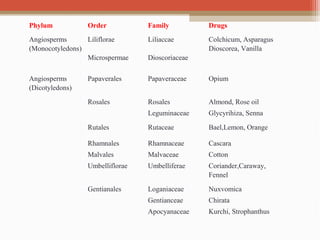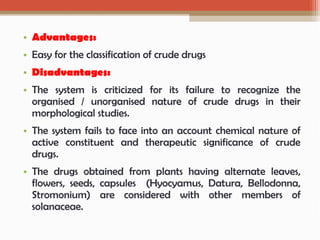Classification of crude drugs
- 1. Dr.U.Srinivasa, D.Pharm, M. Pharm., M.Phil., Ph.D. Professor and Head, (Dept. of Pharmacognosy) Srinivas college of pharmacy, Mangalore. Email.sreenivas1966@rediffmail.com/drsrinivaspharmacy@ ediffmail.com CLASSIFICATION OF CRUDE DRUGS
- 2. Classification of crude drugs • Crude drug i.e Simple drug • Crude drugs are plant, animal or their parts which after collection are subjected only to drying or making them into transverse/ longitudinal slices pieces or peeling them in some cases. They exist in natural form. • Crude drugs may be derived from various natural sources like plants, animals, minerals and micro- organisms etc.
- 3. • Because of their wide distribution the arrangement of classification in a definite sequence is necessary to understand easily. Although each system of classification has its own merits and demerits, but for the purpose of study the drugs are classified in the following different ways: Alphabetical classification Morphological classification Taxonomical classification Pharmacological classification Chemical classification Chemo-taxonomical classification
- 4. 1. Alphabetical classification • The crude drugs are arranged according to the alphabetical order/form of their Latin and English names. Some of the Pharmacopoeias and reference books which classify crude drugs according to this system are as follows.
- 5. 1) Indian Pharmacopoeia (IP) 1955 (Latin) 2)Indian Pharmacopoeia (IP) 1966 (English) 3)British Pharmacopoeia (BP) (English) 4)British Pharmacopoeia Codex (BPC) (English) 5)United States of Pharmacopoeia (USP) (English) 6)European Pharmacopoeia (Latin)
- 6. • Advantages: • It is simple method, in this system location, tracing and addition of the drug is easy, • No technical person is required for handling the system. • Disadvantages: • Scientific nature of the drug cannot be identified by this method, whether they are organised or unorganised drug. • This system does not help in distinguishing the drugs of plant, animal and mineral source. (Original source is not
- 7. • Examples: • Acacia, Agar, Benzoin, Beeswax, Cinchona, Cinnamon, Digitalis, Datura, Ephedra, Fennel, Ginger, Isapagol, Jalap, Kino, Linseed, Mustard, Nutmeg, etc.
- 8. 2. Morphological classification: • Here the crude drugs are arranged (Grouped) according to the part of the plant or animal represented into organised (Cellular) drugs and unorganised ( Acellular ) drugs. • Organised (Cellular): • Drugs are the direct parts of the plant and are divided into leaves, barks wood, root, rhizome, seed, fruit, flower, stem, hair and fibers.
- 9. • Unorganised ( Acellular): • Drugs are the products of plant, animal and mineral source and they are divided into dried latex, dried juice, dried extracts, gums, resins, fixed oils and fats, waxes, volatile oil, animal products, minerals (Solids, liquids, semi solids etc).
- 10. Plant parts Drugs Leaves Datura, Senna, Vasaka, Digitalis, Barks Cinnamon, Cinchona, Kurchi, Wood Quassia, Sandalwood, Red sanders Roots Rauwolfia, Liquorice, Ipecac Rhizomes Ginger, Podophyllum, Turmeric Flowers Clove, Saffron, Pyrethrum Seeds Nux vomica, Linseed, Isapgol Fruits Fennel, Coriander, Dill Stems Ephedra Hair and Fibres Cotton, Hemp, Jute Organised drugs (Plant) (Cellular drugs)
- 11. Plant, animal, Mineral Drugs Dried latex Opium, Papain Dried Juice Aloe, Kino Dried extracts Agar, Catechu, Pectin Gums Acacia, Tragacanth, Stericulia Resins Benzoin, Colophony, Asafoetida Fixed oils and fats Castor , Chaulmoogra, Cotton seed Waxes Beeswax, Spermaceti Volatile oils Coriander, Cinnamon, Clove Animal products Bees wax, Shark liver oil, Gelatin Minerals Bentonite, Kaolin, Talc Unorganised drugs (Acellular drugs)
- 12. • Advantages: • This system of classification is more convenient for practical study especially when the chemical nature of the drug is not clearly understood. • This type of classification is very useful in identifying the adulterants used. • Disadvantages: • It does not give an idea about biological source, chemical constituents and uses. • When different parts of the plant contain different chemical constituents, it is difficult to classify them.
- 13. 3. Chemical classifications of crude drugs • Here, the crude drugs are divided into different groups according to the chemical nature of their most important constituent present in the drug to which the pharmacological/therapeutic activity of drug is attributed.
- 14. Chemical constituents Drugs Alkaloids Datura, Vasaka, Vinca, Lobelia Glycosides Cascara, Senna, Digitalis Tannins Catechu, Myrobalan, Ashoka Volatile oil Clove, Eucalyptus, Cinnamon Lipids Castor oil, Beeswax, Arachis oil Carbohydrates and derived products Acacia, Agar, Honey, Linseed Tragacanth, Starch Resins Colophony, Benjoin, Vitamins & hormones Yeast, Shark liver oil, Insulin Proteins & enzymes Gelatin, Papain,
- 15. • Advantages : • Chemical constituents are known, • Medicinal uses are known • Disadvantages : • Drugs of different origin are grouped under similar chemical titles. • This type of classification makes no proper placement of drugs containing two different types of chemicals. • Eg: Certain drugs are found to contain alkaloids and glycosides (Cinchona), Fixed oil and volatile oil (Nutmeg) of equal importance together and hence it is difficult to categorize them properly
- 16. 4. Taxonomical classification of crude drugs • In this system the drug are arranged according to taxonomical studies. The drugs are arranged according to their phylum, order, family, genus and species. It is purely a type of botanical classification or biological classification and restricted mainly to crude drugs from plant source.
- 17. Phylum Order Family Drugs Angiosperms (Monocotyledons) Liliflorae Microspermae Liliaccae Dioscoriaceae Colchicum, Asparagus Dioscorea, Vanilla Angiosperms (Dicotyledons) Papaverales Papaveraceae Opium Rosales Rosales Almond, Rose oil Leguminaceae Glycyrihiza, Senna Rutales Rutaceae Bael,Lemon, Orange Rhamnales Rhamnaceae Cascara Malvales Malvaceae Cotton Umbelliflorae Umbelliferae Coriander,Caraway, Fennel Gentianales Loganiaceae Nuxvomica Gentianceae Chirata Apocyanaceae Kurchi, Strophanthus
- 18. • Advantages: • Easy for the classification of crude drugs • Disadvantages: • The system is criticized for its failure to recognize the organised / unorganised nature of crude drugs in their morphological studies. • The system fails to face into an account chemical nature of active constituent and therapeutic significance of crude drugs. • The drugs obtained from plants having alternate leaves, flowers, seeds, capsules (Hyocyamus, Datura, Bellodonna, Stromonium) are considered with other members of solanaceae.
- 19. 6. Pharmacological classification of crude drugs: • Here, the crude drugs are grouped according to pharmacological action (Therapeutic action) of their chief active constituent (most important) or therapeutic uses.
- 20. • Bitter - Quassia, Cinchona, Gentian • Carminatives - Dill, Clove, Fennel, Coriander • Emetics - Ipecac • Anti-amoebic - Kurchi, Ipecac • Bulk Laxatives - Agar, Isapgol • Purgatives - Senna, Castor oil • Expectorant - Liquorice, Vasaka, Ipecac • Antitussive - Opium • Bronchodilators - Ephedra, Tea • Cardio- tonics - Digitalis, Squill, Stropanthus
- 21. • Cardiac depressant - Cinchona, Veratrum • Antihypertensive - Rauwolfia • Central analgesics - Opium • CNS stimulants - Coffee • CNS depressants - Opium • Antispasmodics - Bellodonna • Anticancer - Vinca, Podophyllum, Cochicum • Antirheumatics - Aconite, Guggul, Colchicum • Anthelmintics - Vidang, Quassia, Malefern • Astringents - Catechu. • Antimalarials - Cinchona, Artemisia. • Local anesthetics - Coca
- 22. • Advantages • The special advantage is that if even chemical constituents of the crude drugs are not known they can be classified properly on the basis of therapeutic or pharmacological uses. • Disadvantages • Regardless of morphology, taxonomical status or chemical nature, the drugs are grouped together, provided they exhibit similar pharmacological uses. • Eg: Senna, Castor oil, Jalap, Colocynth are grouped together as purgatives/laxatives because of their common pharmacological action.
- 23. 6. Chemo- taxonomical classification of crude drugs • In this system of classification, the equal importance is given for taxonomical status and chemical constituents. There are certain types of chemical constituents which are characteristics of certain classes of plants. • Eg: Tropane alkaloids generally occur in most of the members of Solanaceae • Eg: Volatile oils occur in the members of Umbelliferae and Rutaceae.
- 24. Question bank • 1. Define crude drug 2 marks • 2. Name the various methods of classification of crude drugs. 2 marks • 3. What do you mean by organised ( Cellular) and unorganised ( Acellular ) crude drugs give examples 5 marks • 4. Describe morphological classification of crude drugs with examples 5 marks • 5. Explain chemical classification of crude drugs with examples 5 marks • 6.Explain chemical classification of crude drugs with
- 25. • 7.Explain pharmacological or therapeutic classification of crude drugs with examples 5 marks • 8. Write in detail alphabetical and taxonomical or botanical classification of crude drugs 5 marks • 9. Define chemotaxonomy. Give its significances or importance's 5 marks • 10. Explain the differences between organised and unorganised crude drugs. 5 marks • 11. Define crude drug. Explain various methods of classification of crude drugs with examples 10 marks


























